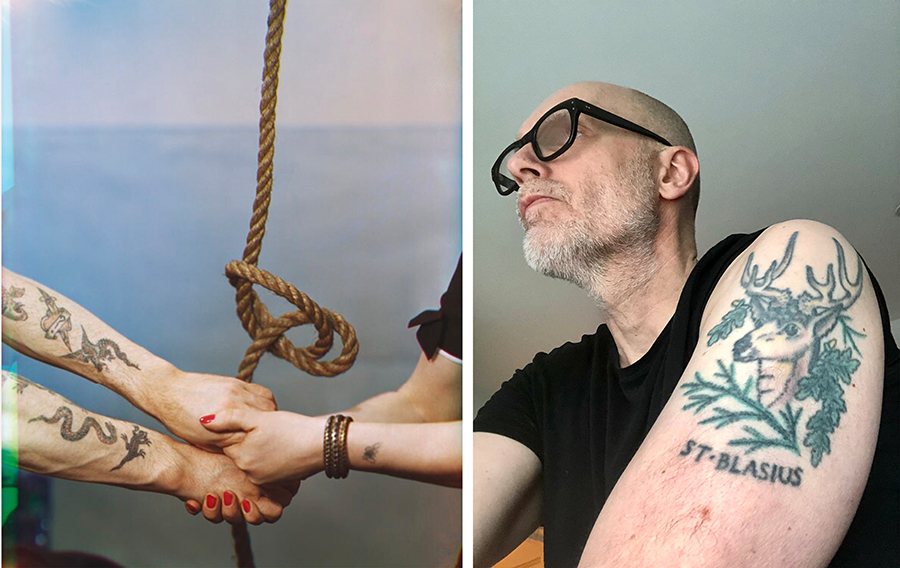
Tattoo by Yevonde, tri-colour separation negative, 1938 © National Portrait Gallery. London – Richard Ansett with tattoo, self portrait, iPhone 15, 2023
“There is a temptation to try and make sense of Madame Yevonde’s compelling tattoo studies and I confess I made this mistake when Clare Freestone, curator of the National Portrait Gallery exhibition ‘Life and Color’, first invited me to respond to this series. Early photography can have a ‘found’ element if it appears to be detached from its original purpose, like a pile of old photographs in a junk shop, part of the appeal is in its mystery but this distance can also expose it to the mis-judgement of our contemporary gaze.
Freestone celebrates Madame Yevonde, as previously under-represented pioneer of the medium and in her research for the exhibition and catalogue, she reveals the photographer’s early color experiments as pivotal to the medium’s evolution. Color’s closer facsimile to life (relative to black and white) is skilfully manipulated by Yevonde who overcomes significant technical challenges to transcend reality in her unique, dare I say camp creations. Camp is something I understand and my own creations with my long suffering subject and muse Sir Grayson Perry may have inspired Clare Freestone to ask me specifically to respond to these mysterious tattoo images.
In my failed quest to de-code them, I returned to the meticulously researched catalogue and within these pages there are hints of the dichotomy between Yevonde’s commitment to social equality for women, with a marriage which seems, from our present perspective, in direct contrast to her well documented feminist credentials. Further investigation reveals her documented happy marriage to the playwright Edgar Middleton, whose autobiography includes chapters with provocative titles like Women aren’t wonderful and Why I hate women are so jarring, its hard to reconcile Yevonde, the amazing trailblazer with the idea of her as the devoted wife to a card carrying mysogynist. But perhaps, like the tattoo images themselves, the context has been lost in time and I am bringing that same contemporary judgement (and my own) that may not fairly represent them or the times. BUT no matter how uncomfortable or misguided, this introduces an additional filter through which to explore my relationship to the tattoo works and I now see them partly as a betrayal of an artist’s longing for romantic and sexual escape. In one of the images a model’s bejewelled hand caresses the exotic fruit juxtaposed with a loosened love knot.
Are these the subconscious accidents of a woman trapped between two worlds? Could they be a coded communication from an era in revolution, a message in a bottle sent to the future from a woman wrestling with her own complex relationship and sexuality? Or perhaps a woman at odds with the deep seated conservative notions instilled by society then that we can still recognise now. Ultimately though, sometimes the more we discover the less we understand.
In Yevonde’s era, tattoos once only considered the product of the ‘unrestrained passion of the lower classes’, had become an essential ‘accoutrement’ for the fashionable and they speak as much to the unexplored desire of the repressed middle and upper class. An anonymous sailor grabs the ropes of a mysterious ship, absconding with an unknown woman (perhaps Yevonde herself), her own dalliance with sexual and romantic salvation represented by a daring little butterfly tattoo? I’m projecting now, it’s me and I’m on board this fantasy vessel with my hunky sailor, pulling on the rigging together against a Gauguin-esq sky. These images are triggering memories of my own unfulfilled passion as a young gay man and the thrill and adventure that accompanied my daring escape from heteronormative reality.
It is a mistake to consider these studies as merely incomplete pieces of evidence whose meaning has been lost in time. We can misunderstand photography as merely documentation rather than the fascinating and complex art form that it is. We can never truly understand the mind that created these images and in the attempt to unravel a mystery we can miss the bigger picture. Like the best art, they inspire a deeply personal response because of, rather than in spite of their ambiguity – that is their power.”
In the 1990’s HIV AIDS was still a terrifying prospect. By that time we all knew the risks but there were still moments when I, like many others, dared to roll the dice.
I had a high risk encounter which left me greatly fearful for my own health and when I developed an unshakable throat infection, I was engulfed with a private shame and mortal terror. When I arrived for my appointment with a specialist Ear Nose and Throat hospital in London, I was barely able to manage this anxiety, convinced that my life as I understood it might be over. In the atrium was a statue of Saint Blasius the patron saint of throats.
With nowhere to park my hopelessness in that moment and I made a silent pact with the traditional God of my childhood that if I was reprieved I would permanently mark myself with a tattoo of the name of the saint as punishment for my atheist hypocrisy. It now sits quietly on my arm, as ambiguous as Madame Yolande’s to those that don’t know me as a vital reminder of the limits of myself.